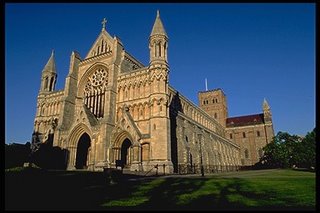
Until the mid-20th century, when Dom Gregory Dix proposed otherwise, the most common explanation for the verbal differences between the eucharistic rites of 1549 and 1552 involved the political pressures exerted on liturgical reform, and on Cranmer himself, in the last half of the reign of Edward VI. The
coup de tat that brought down the Somerset government also replaced its cautious and moderate religious reform (in keeping with Cranmer’s own views) with the more radical and thoroughgoing agenda of the Northumberland regime. Significantly this change ushered in a favorable climate for the political ascendancy of the Züricher party -– consisting of reformers of Zwinglian sympathies such as John Hooper, Bp. of Gloucester.
Of the two rites, 1549 was seen as more in keeping with Cranmer’s mind in its articulation of Christ’s presence in the Eucharist. This did not mean, however, that the 1552 rite constituted a “different mind” or a fully Zwinglian alternative; but rather one that, for political reasons, had been crafted to be more Zwinglian-friendly. This view remained the standard reading of Cranmer's two liturgical projects up to the early 20th century, even among prominent Anglo-Catholic liturgical scholars such as the godly Bishop of Truro, Walter Howard Frere.
The beauty of this explanation lies in how well it explains three seemingly conflicting elements in the story of the liturgical reform that had produced the two Books of Common Prayer. The first was Cranmer’s insistence throughout the latter years of his life that he had only ever held two views of eucharistic presence: transubstantiation, and what he came to refer to as the “true and catholic doctrine” of the Supper, a view that he had come to embrace by ca. 1546. The second element consisted of the verbal changes themselves: namely, the softening, and in some cases the removal, of the 1549 rite’s overt instrumental/objectivist language to produce a rite significantly more palatable to the Zürichers. The third element was the fact that, even after the changes and often in spite of them, the rite could still continue to support a catholic reading, a fact celebrated by E.B. Pusey in Tract 80 (1836). It’s in this third element – this liturgical “sleight of hand” – where Cranmer’s true genius shines through.
A striking example of this sleight of hand can be seen in the removal of the phrase “in these holy mysteries” from the Prayer of Humble Access in 1552:
"Grant us therefore, gracious Lord, so to eat the flesh of thy dear Son Jesus Christ, and to drink his blood
in these holy mysteries…"
To eat the body and drink the blood of Christ “in these holy mysteries” (i.e. consuming the elements) assumes an instrumental and objectivist understanding of Christ’s presence in the Supper; an understanding utterly abhorrent to Zwinglians of the period, as evidenced by Bp. Hooper’s refusal to use the new Prayer Book for this and similar reasons. Yet, while the removal of the phrase went far to placate those of Zwinglian sympathies, to suggest that this change irreparably altered the theology of the prayer would be a huge overstatement. The Prayer of Humble Access, even without its fuller catholic expression, was still capable of supporting its natural catholic meaning.
But such blunting of the instrumental and objective language would inevitably cause some of his contemporaries to wonder aloud whether Cranmer had shifted to more a continental Reformed view. This Cranmer adamantly denied to his dying day; and no serious scholar, not even Dix, ever questioned this testimony until quite recent times.
Where Dix departed from conventional wisdom was not in contradicting Cranmer’s testimony on this matter, but rather in proposing that the 1552 rite, not the 1549, expressed Cranmer’s “true mind” during his Protestant period, and, moreover, that this true mind was decidedly “Zwinglian.” For Dix, the changes made to the 1552 edition (rather than the edition itself) were evidence not only of Zwinglian influences on liturgical reform, but also of overt Zwinglianism in Cranmer himself. And since Dix believed that Cranmer was a Zwinglian even before he wrote the 1549 rite, then logically the 1549 rite must be Zwinglian too!
The problem that Dix would encounter, and one he would never be able to explain adequately, was the language of the 1549 rite. If Cranmer was a convinced Zwinglian as early as, say, 1548, then how could he have been so careless (deliberate?) in the use of such instrumental language of presence? The best that Dix could do was to explain away the language of 1549 as “ambiguous,” the sense of which would be “fully perfected” in the rite of 1552. In the final analysis, the 1549 rite was "guilty," not on account of its own deficiencies, but merely by association.
Thus, for Dix, the interpretive key to reading anything that Cranmer ever wrote on the Eucharist (even the 1549 rite) was to read backwards from 1552 through Zwinglian spectacles. Once this modus operandi is appreciated one can begin to see more clearly the motive and agenda behind it: nothing less than the full discrediting of the Cranmerian Prayer Book tradition.
Until next time.







